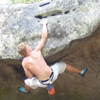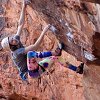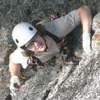The following is an email I sent to CBC Radio. Who knows if anything will come of it.
I just heard that the school board in HRM has banned indoor rock climbing for children below highschool age.
I think this is unfortunate as indoor rock climbing is one of the few activities where the perceived risk is so much higher than the actual risk. It gives children a chance to practice evaluating risk in a safe environment. It also gets children used to the idea of using safety equipment. This all works on the brain’s instinctive tendency to relate height to danger even if you are safely secured to a rope. So while the activity is as safe as playing a game of soccer, the impact of the experience is so much more. The practice children get in assessing risk while facing their fears in indoor rock climbing may save their lives when they are exposed to dangerous activities as teenagers.
I think this ties in quite well with a study I heard about on CBC Radio that looked at the effect of removing monkey bars from playgrounds to reduce the risk of injury. The conclusion of that study, if I recall correctly, was that although it decreased the chance of young children experiencing minor injuries, it also removed opportunities for the children to practice risk assessment, which resulted in teenagers who were less able to correctly evaluate risk. Or in other words, the lessons learned through getting some bumps and scraps early in life can prevent young people from making potentially fatal decisions later.
I think the decision to ban indoor rock climbing for grade school and junior high students is ill advised. This decision, particularly if it is part of a wider trend, is detrimental to the healthy development of our youth.
Teth Cleveland
School Board bans rock climbing, opportunity missed.
Moderators: chossmonkey, Dom, granite_grrl, peter, Climb Nova Scotia, Matt Peck
9 posts
• Page 1 of 1
Re: School Board bans rock climbing, opportunity missed.
It has taken a while but my 4 year old can now climb to the top of our climbing wall in the garage. She started with small steps realizing that she can back-track her moves to down-climb. She took it one step further each time raising the bar of "risk". She is evaluating and learning about the environment and potential risks on here own.
Was their decision based on any kind of risk assessment or report? Or did some ignorant jock committee come to this conclusion? And by jocks, I mean your "all-american" types... football, hockey, soccer...
Was their decision based on any kind of risk assessment or report? Or did some ignorant jock committee come to this conclusion? And by jocks, I mean your "all-american" types... football, hockey, soccer...
I want to go to hell... there's probably lots of rock to climb there.
-

Fred - Site Admin
- Posts: 3140
- Joined: Wed Oct 20, 2004 12:30 am
- Location: Fredericton, NB
Re: School Board bans rock climbing, opportunity missed.
Hey Teth,
Thanks for passing that along. Where did you hear that the school board had taken this action? As far as Climb Nova Scotia was aware, HRM had decided "for insurance reasons" to disallow construction of any new climbing walls in city public schools, but this is the first I've heard of an outright ban.
Do you have a link or any more details?
mick
Thanks for passing that along. Where did you hear that the school board had taken this action? As far as Climb Nova Scotia was aware, HRM had decided "for insurance reasons" to disallow construction of any new climbing walls in city public schools, but this is the first I've heard of an outright ban.
Do you have a link or any more details?
mick
-

mick - Posts: 399
- Joined: Mon Aug 13, 2007 2:23 pm
Re: School Board bans rock climbing, opportunity missed.
Ironic that they would ban rock climbing, but spend $230,000 on ATV's for children. However, much like driving motor vehicles, rock climbing is inherently dangerous and even experience climbers have lost their lives. The waivers for the basket ball team doesn't list death as a possibility. I don't think that we should be attracting new people to the sport by advertising that it is as safe as soccer.
As summarized by the American Safe Climbing Association: If you are seeking security, DO NOT CLIMB. To quote Helen Keller, "Life is either a daring adventure or nothing at all." Climbing of any type inherently involves the risk of death. Those hiding their unwillingness to take responsibility for their own actions behind the current legal system of the U.S. should never attempt to climb anything.
The above is an American opinion reflected by their obsession with litigation. I think we can find a more Canadian way to deal with this issue. The balancing act comes in making sure new climbers, children, and parents understand the vigorous need for safety without scaring them away from an amazing experience. The goal should be informed consent and allow the individual to choose if the benefits outweigh the risks (which we all agree is certainly the case). Informed consent requires that significant risks be disclosed, as well as risks which would be of particular importance to that person (i.e. death, even though it is not a significant risk statistically speaking). Informed consent also includes taking reasonable steps so as to be relatively satisfied that the person does understand the information being provided.
So lets be realistic, put the risks in perspective, highlight the benefits, and go climbing!
As summarized by the American Safe Climbing Association: If you are seeking security, DO NOT CLIMB. To quote Helen Keller, "Life is either a daring adventure or nothing at all." Climbing of any type inherently involves the risk of death. Those hiding their unwillingness to take responsibility for their own actions behind the current legal system of the U.S. should never attempt to climb anything.
The above is an American opinion reflected by their obsession with litigation. I think we can find a more Canadian way to deal with this issue. The balancing act comes in making sure new climbers, children, and parents understand the vigorous need for safety without scaring them away from an amazing experience. The goal should be informed consent and allow the individual to choose if the benefits outweigh the risks (which we all agree is certainly the case). Informed consent requires that significant risks be disclosed, as well as risks which would be of particular importance to that person (i.e. death, even though it is not a significant risk statistically speaking). Informed consent also includes taking reasonable steps so as to be relatively satisfied that the person does understand the information being provided.
So lets be realistic, put the risks in perspective, highlight the benefits, and go climbing!
- Quinn
- Posts: 123
- Joined: Wed Oct 28, 2009 9:54 pm
Re: School Board bans rock climbing, opportunity missed.
I think "risk of death" is a phrase to stay away from. Almost anything you do contains some amount of risk of death, for example driving a car is a pretty dangerous activity! It's a truism that will just allow for more knee-jerk reactions.
Soccer is probably not a great example as it really is a relatively low risk sport.
There was an article I read some time ago that compared the risks of indoor wall climbing to other common high school sports, and the injuries (and deaths too sadly) sustained while playing american football or cheerleading were both significantly higher. These are both much better comparisons I think, both because they are more common and because they both contain very real risks of paralysis and death. And in Canada, hockey is of course an obvious addition. I am saddened but not surprised to hear there has been no critical thinking done about this on part of the school board and I wonder how it even came up as an issue?
Soccer is probably not a great example as it really is a relatively low risk sport.
There was an article I read some time ago that compared the risks of indoor wall climbing to other common high school sports, and the injuries (and deaths too sadly) sustained while playing american football or cheerleading were both significantly higher. These are both much better comparisons I think, both because they are more common and because they both contain very real risks of paralysis and death. And in Canada, hockey is of course an obvious addition. I am saddened but not surprised to hear there has been no critical thinking done about this on part of the school board and I wonder how it even came up as an issue?
-

patzer - Posts: 140
- Joined: Sat Jul 02, 2005 1:53 pm
Re: School Board bans rock climbing, opportunity missed.
This development isn't good for anyone. The community, the local business that are involved in climbing and climbing related goods, or all those kids that will miss an opportunity to be exposed to a new activity.
I'm also interested in where you found this information and any reports and notes on why this decision was made.
Sean T, do you have any insights into this development? Are/Were you aware of this, or consulted in any way? Obviously, it is going to affect your business. School groups are a major source of income for gyms, they are also a very effective method of promoting. Once a kid has tried the walls with their school, they then want to have their birthday party there.
I think this will also have detrimental effects on the development of the NS climbing community.
I'm sadened by this news. The last 5 years I've been working in outdoor education and in gyms teaching kids to climb. I get a lot of satisfaction by seeing them progess, learn, evaluate risks, and succeed (or not, but it is still a valuable teaching opportunity and experience!). I'm coaching 13 year old kids right now who are LEADING! If kids aren't introduced to climbing while they're young, I believe that they will be less likely to become involved later in life.
I would like to know more, so if anyone hears anything, please, post up!
I'm also interested in where you found this information and any reports and notes on why this decision was made.
Sean T, do you have any insights into this development? Are/Were you aware of this, or consulted in any way? Obviously, it is going to affect your business. School groups are a major source of income for gyms, they are also a very effective method of promoting. Once a kid has tried the walls with their school, they then want to have their birthday party there.
I think this will also have detrimental effects on the development of the NS climbing community.
I'm sadened by this news. The last 5 years I've been working in outdoor education and in gyms teaching kids to climb. I get a lot of satisfaction by seeing them progess, learn, evaluate risks, and succeed (or not, but it is still a valuable teaching opportunity and experience!). I'm coaching 13 year old kids right now who are LEADING! If kids aren't introduced to climbing while they're young, I believe that they will be less likely to become involved later in life.
I would like to know more, so if anyone hears anything, please, post up!
- the kydd
- Posts: 101
- Joined: Wed Sep 12, 2007 10:55 am
Re: School Board bans rock climbing, opportunity missed.
the Teth,
If your letter is as well written as your post, than I hope it will be well received. Unfortunately, I believe the insurance industry and the American-style fear of litigation is becoming ever present in our educational institutions. This is becoming ever more prevalent even at the University level (where the participants are old enough to truly understand the risks involved and waive them off). In the past year, the UNB climbing club is having to jump through an increasing number of hurdles in the form of paperwork, safety assessments, and liability concerns. All of these stem from the University's new Risk Assessment managers, who are paid to minimize exposure to liability, in order to minimize insurance costs. It is the perception of risk, rather than real risk, which is leading to misinformed policy such as the banning you're speaking of. I hope you're successful in dispelling the myth.
p.s. if this is another hoax like the one I fell for a few months back I'm never posting here again. ahh... damn... who am I kidding. Posting in another Province's forum is like binge drinking when you're too old. You do it. You get burnt for it the next day. You swear it'll never happen again... and then a few weeks later your right back at it. A cycle of abuse. Know any good support groups Chossmonkey?
If your letter is as well written as your post, than I hope it will be well received. Unfortunately, I believe the insurance industry and the American-style fear of litigation is becoming ever present in our educational institutions. This is becoming ever more prevalent even at the University level (where the participants are old enough to truly understand the risks involved and waive them off). In the past year, the UNB climbing club is having to jump through an increasing number of hurdles in the form of paperwork, safety assessments, and liability concerns. All of these stem from the University's new Risk Assessment managers, who are paid to minimize exposure to liability, in order to minimize insurance costs. It is the perception of risk, rather than real risk, which is leading to misinformed policy such as the banning you're speaking of. I hope you're successful in dispelling the myth.
p.s. if this is another hoax like the one I fell for a few months back I'm never posting here again. ahh... damn... who am I kidding. Posting in another Province's forum is like binge drinking when you're too old. You do it. You get burnt for it the next day. You swear it'll never happen again... and then a few weeks later your right back at it. A cycle of abuse. Know any good support groups Chossmonkey?
-

*Chris* - Posts: 848
- Joined: Wed Apr 19, 2006 2:32 pm
- Location: Fredericton
Re: School Board bans rock climbing, opportunity missed.
Mick:
Sean T told me about it. His wife is a teacher and this policy change has huge impacts on his business. The purpose of my letter to CBC radio was to perk their interest, so that they would research it further.
Quinn:
The topic was indoor rock climbing. Not rock climbing in general. To put the risks in perspective, the risk of injury while rock climbing in a monitored indoor facility is about one third the risk of injury while participating in a school gymnastics program. They are more likely to hurt themselves if they run around and trip while they are not climbing.
You are right though. I should have used Hocky instead of Soccer as my comparison. The reason I did not do so is that I believe Hocky is more dangerous than indoor rock climbing.
Sean T told me about it. His wife is a teacher and this policy change has huge impacts on his business. The purpose of my letter to CBC radio was to perk their interest, so that they would research it further.
Quinn:
The topic was indoor rock climbing. Not rock climbing in general. To put the risks in perspective, the risk of injury while rock climbing in a monitored indoor facility is about one third the risk of injury while participating in a school gymnastics program. They are more likely to hurt themselves if they run around and trip while they are not climbing.
You are right though. I should have used Hocky instead of Soccer as my comparison. The reason I did not do so is that I believe Hocky is more dangerous than indoor rock climbing.
The Teth
-

The Teth - Posts: 453
- Joined: Wed Oct 27, 2004 1:01 pm
- Location: Halifax
Re: School Board bans rock climbing, opportunity missed.
Just for further clarification, I am referring to school groups with kids on top ropes and parents/teachers belaying with staff supervision, or kids bouldering at a height no greater than ten feet, with padded floors.
I am not talking about indoor climbing competitions with boulding problems going up to 16 feet, or indoor leading. I am referring to kid groups, which are even more controlled than normal indoor climbing. With the amount of school groups and birthday parties in the last ten years between Ground Zero, and the RockWorks/Beyond Gravity, how many injuries has their been?
I am not talking about indoor climbing competitions with boulding problems going up to 16 feet, or indoor leading. I am referring to kid groups, which are even more controlled than normal indoor climbing. With the amount of school groups and birthday parties in the last ten years between Ground Zero, and the RockWorks/Beyond Gravity, how many injuries has their been?
The Teth
-

The Teth - Posts: 453
- Joined: Wed Oct 27, 2004 1:01 pm
- Location: Halifax
9 posts
• Page 1 of 1
Who is online
Users browsing this forum: No registered users and 2 guests